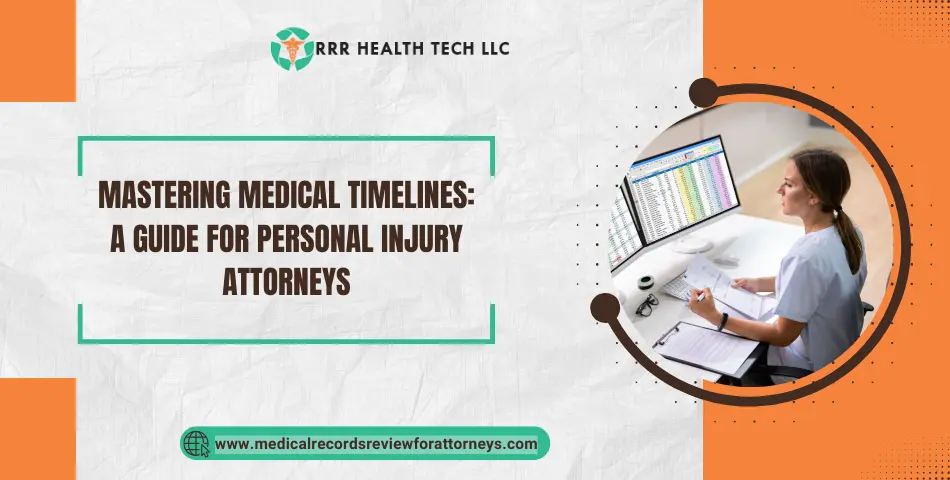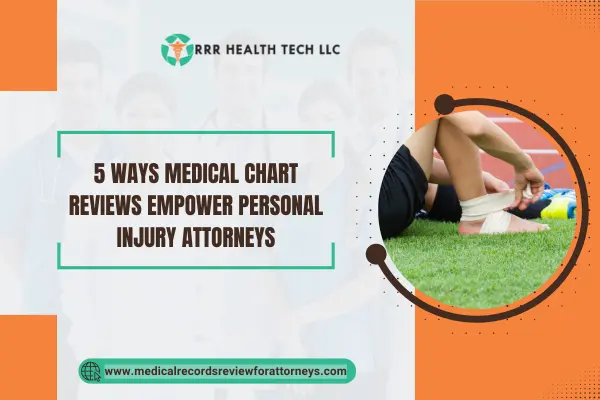
Introduction
The portrayal of the injurious effect of an injury on a client’s life is a crucial component in personal injury cases, and the medical timelines must be presented and incorporated clearly and accurately. Medical timelines can be employed as demonstrative evidence. They illustrate the chronology of medical procedures, treatments, and auxiliary complications that arise due to an injury. These timelines assist attorneys in attributing negligence, damage calculations, and settlement discussions.
This chapter will explain the role medical timelines play in personal injury cases, their constituents, the obstacles faced in their construction, and the strategy for formulating a medical chronology.
Understanding Medical Timelines and Their Role in Personal Injury Cases
Medical timelines are the skeleton files of an individual’s medical history, consisting of their medical visits, procedures done, and diagnosis over a given time frame. They graphically outline the progression of an injury, which is a great aid to attorneys when presenting a case. Medical timelines are key in personal injury, medical malpractice, as well as wrongful death cases, for determining causation, the degree and severity of injuries, as well as the result of medical treatments performed on the patient. The timeline is further supported by case related medical exhibits such as diagnostic films, operative reports, and narrative reports.
Key Components of an Effective Medical Timeline
For attorneys, the major ingredients of a medical timeline are:
- Client’s injuries – Precisely how the injury was sustained.
- Pain management treatments – such as the recording of medications, therapeutic procedures, and injections.
- Surgical procedures and errors – Enumeration of surgical procedures and reported complications or sequelae about the surgery.
- Physical therapy sessions – Integration of therapy services to help with improvement and recovery.
- Hospital admissions and discharge summaries – Gives a summary of the care provided in the hospital.
- Residual conditions and Maximum Medical Improvement (MMI) – Suggest the degree of remaining impact due to the illness and the level of perpetuity of health status.
To be effective in the strategy of negotiating, mediating, and litigating personal injury claims, these exhibits should be crafted with attention to detail and comprehensiveness that is specific to the case in question.
Benefits and Challenges in Crafting Detailed Medical Chronologies for Personal Injury Cases
Benefits:
- Clear presentation of medical evidence – Merges detailed medical documents into a single document or set of clear, descriptive files for the lawyer and the jury.
- Enhanced settlement process – Guarantees more effective negotiations with insurance coverage by proving the magnitude of the inflicted injury and care required.
- Improved case strategy – Provision of medical evidence the lawyer must establish allows him/her to better strategize the legal process.
- Stronger expert witness testimony – Assisting in presenting the factors due by the doctors that patients and other practitioners treated the patients to substantiate the conditions.
Challenges:
- Volume of medical records – It is difficult to filter valuable information from the enormous pile of documents.
- Accuracy in sequence of medical events – Placing every medical appointment and treatment or surgery with all its complications in order in which they were executed.
- Medical terminology and complexity – Analyzing statements made in the medical documents and transforming them into legally applicable language.
- Discovery phase and evidence gathering – This step consists of collecting relevant medical records and diagnostic films needed to prepare the case presentation.
Challenges in Creating Accurate Medical Timelines for Personal Injury Cases
Establishing a certain timeline within a personal injury claim case comes with several setbacks such as:
- Incomplete medical records – The absence of records from certain health care providers could hamper the completion of the timeline.
- Statute of limitations (SOL) – Making sure that medical evidence correlates with the time frame legally permitted to file the case.
- Conflicting medical opinions – Treating physician and other medical experts may have different opinions as to what the physician should be in charge.
- Insurance company negotiations – Those representing the insurance company often disagree as to how serious the injury is or even whether the treatment is warranted. Well-supported medical timelines are indispensable in these cases to ensure compensation is paid.
Medical Timeline Creation in Personal Injury Cases
To achieve the desired objectives, personal injury lawyers should ensure that the medical timelines in their cases are:
- Factually accurate – All relevant medical records and reports are included.
- Visually effective – Through the use of charts, graphs, and other demonstrative evidence.
- Legally sound – relevant to personal injury claim standards and discovery phase requirements.
- Chronologically structured – Developing a logical flow of all the medical events in time.
Steps to Prepare Effective Medical Chronology for Personal Injury Cases
- Gather Medical Records – Secure all paperwork related to the patient’s medical history, including hospital admissions, operations, and physical therapy sessions.
- Organize Records by Date – Sort treatments and medical checkups chronologically to maintain order.
- Identify Key Events – Mark important events such as the finding of the diagnosis, mistakes in surgery, and issues after surgery.
- Cross-Reference with Legal Timelines – Synchronize medical timelines with the stages of the personal injury claim and its litigation processes.
- Create Case-Specific Medical Exhibits – Incorporate visual materials, narrative reports, and demonstrative materials for aid in the case presentation.
- Review with Medical Experts – Verify information with the treating physicians and the physician expert witnesses to make sure the facts are correct.
- Use in Negotiation and Mediation – The medical chronology can be used in negotiations with the defendant to demonstrate why the claimant should be awarded the compensation after the settlement.
Conclusion
Having medical chronologies aids case preparation for personal injury attorneys, enabling them to prepare the cases with the necessary materials that best serve their interests. With the elaborate attempts placed on case-specific medical chronologies, attorneys increase the efficacy of their legal maneuvers, clinical outcomes, and the level of reimbursement within personal injury lawsuits. When dealing with insurance providers, during trials, or within pretrial stages, an accurately structured time frame of all medical steps is done to ensure that no detail is omitted.
FAQs
Is there a time limit on personal injury claims?
Yes, personal injury claims do have a time limit, which is the subject of a statute of limitations legislation. This period differs from region to region. You must apply for aid within the time frame set by law, so you stand a better chance of receiving compensation.
What is the time limit for claiming compensation?
The deadline for applying depends on the laws in the state and the kind of the claim, like for a medical abuse or unjust death case. Attorneys should confirm what statutes are in force so there are no delays.
What is the medical record chronology?
These files consist of the treatments done, diagnostic films, operational reports, smear reports, and all other necessary supporting documents, which assist in justifying the claim for personal injuries, and are organized by time.
Reach out to RRR Health Tech today if you are looking for expertise in developing clear and concise medical timelines for your cases. Our specialists will increase the chances of your clients getting more compensation by efficiently presenting your cases.


